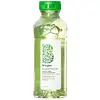What's inside
What's inside
 Key Ingredients
Key Ingredients

 Benefits
Benefits

 Concerns
Concerns

 Ingredients Side-by-side
Ingredients Side-by-side

Water
Skin ConditioningSodium Cocoyl Isethionate
CleansingCocamidopropyl Hydroxysultaine
CleansingCoco-Glucoside
CleansingGlycol Distearate
EmollientSqualane
EmollientHippophae Rhamnoides Fruit/Seed Oil
AntimicrobialBrassica Campestris Seed Oil
Skin ConditioningSesamum Indicum Seed Oil
EmollientCocos Nucifera Oil
MaskingSodium Hyaluronate
HumectantPolyglutamic Acid
Skin ConditioningSpirulina Platensis Extract
Skin ProtectingCocos Nucifera Water
MaskingEmblica Officinalis Fruit Extract
Skin ConditioningCurcuma Longa Root Extract
MaskingLeuconostoc/Radish Root Ferment Filtrate
AntimicrobialCocamide Mipa
EmulsifyingCoconut Acid
CleansingPolyester-11
Skin ConditioningGuar Hydroxypropyltrimonium Chloride
Skin ConditioningPolyquaternium-7
Polyquaternium-73
Sodium Methyl Cocoyl Taurate
CleansingTetrasodium Glutamate Diacetate
Sodium Benzoate
MaskingSodium Isethionate
CleansingSodium Hydroxide
BufferingSodium Chloride
MaskingCitric Acid
BufferingPotassium Sorbate
PreservativePhenoxyethanol
PreservativeParfum
MaskingBenzyl Benzoate
AntimicrobialHydroxycitronellal
PerfumingLimonene
PerfumingWater, Sodium Cocoyl Isethionate, Cocamidopropyl Hydroxysultaine, Coco-Glucoside, Glycol Distearate, Squalane, Hippophae Rhamnoides Fruit/Seed Oil, Brassica Campestris Seed Oil, Sesamum Indicum Seed Oil, Cocos Nucifera Oil, Sodium Hyaluronate, Polyglutamic Acid, Spirulina Platensis Extract, Cocos Nucifera Water, Emblica Officinalis Fruit Extract, Curcuma Longa Root Extract, Leuconostoc/Radish Root Ferment Filtrate, Cocamide Mipa, Coconut Acid, Polyester-11, Guar Hydroxypropyltrimonium Chloride, Polyquaternium-7, Polyquaternium-73, Sodium Methyl Cocoyl Taurate, Tetrasodium Glutamate Diacetate, Sodium Benzoate, Sodium Isethionate, Sodium Hydroxide, Sodium Chloride, Citric Acid, Potassium Sorbate, Phenoxyethanol, Parfum, Benzyl Benzoate, Hydroxycitronellal, Limonene
Water
Skin ConditioningCocamidopropyl Betaine
CleansingSodium Cocoyl Isethionate
CleansingCaprylyl/Capryl Glucoside
CleansingGlycerin
HumectantAloe Barbadensis Leaf Juice
Skin ConditioningSpinacia Oleracea Leaf Extract
Skin ConditioningBrassica Oleracea Italica Extract
AstringentPyrus Malus Fruit Extract
Skin ConditioningCucumis Sativus Fruit Extract
EmollientCitrus Limon Fruit Extract
MaskingCitrus Grandis Fruit Extract
AstringentCitrus Aurantium Dulcis Fruit Extract
MaskingBeta Vulgaris Root Extract
Skin ConditioningCamellia Sinensis Leaf Extract
AntimicrobialCymbopogon Citratus Extract
Skin ConditioningChlorella Vulgaris Extract
Skin ConditioningPanthenol
Skin ConditioningPanthenyl Hydroxypropyl Steardimonium Chloride
Sodium Gluconate
Skin ConditioningSodium Lauryl Sulfoacetate
CleansingCaprylhydroxamic Acid
Polyquaternium-7
Benzyl Alcohol
PerfumingParfum
MaskingCI 75810
Cosmetic ColorantWater, Cocamidopropyl Betaine, Sodium Cocoyl Isethionate, Caprylyl/Capryl Glucoside, Glycerin, Aloe Barbadensis Leaf Juice, Spinacia Oleracea Leaf Extract, Brassica Oleracea Italica Extract, Pyrus Malus Fruit Extract, Cucumis Sativus Fruit Extract, Citrus Limon Fruit Extract, Citrus Grandis Fruit Extract, Citrus Aurantium Dulcis Fruit Extract, Beta Vulgaris Root Extract, Camellia Sinensis Leaf Extract, Cymbopogon Citratus Extract, Chlorella Vulgaris Extract, Panthenol, Panthenyl Hydroxypropyl Steardimonium Chloride, Sodium Gluconate, Sodium Lauryl Sulfoacetate, Caprylhydroxamic Acid, Polyquaternium-7, Benzyl Alcohol, Parfum, CI 75810
 Reviews
Reviews

Ingredients Explained
These ingredients are found in both products.
Ingredients higher up in an ingredient list are typically present in a larger amount.
Parfum is a catch-all term for an ingredient or more that is used to give a scent to products.
Also called "fragrance", this ingredient can be a blend of hundreds of chemicals or plant oils. This means every product with "fragrance" or "parfum" in the ingredients list is a different mixture.
For instance, Habanolide is a proprietary trade name for a specific aroma chemical. When used as a fragrance ingredient in cosmetics, most aroma chemicals fall under the broad labeling category of “FRAGRANCE” or “PARFUM” according to EU and US regulations.
The term 'parfum' or 'fragrance' is not regulated in many countries. In many cases, it is up to the brand to define this term.
For instance, many brands choose to label themselves as "fragrance-free" because they are not using synthetic fragrances. However, their products may still contain ingredients such as essential oils that are considered a fragrance by INCI standards.
One example is Calendula flower extract. Calendula is an essential oil that still imparts a scent or 'fragrance'.
Depending on the blend, the ingredients in the mixture can cause allergies and sensitivities on the skin. Some ingredients that are known EU allergens include linalool and citronellol.
Parfum can also be used to mask or cover an unpleasant scent.
The bottom line is: not all fragrances/parfum/ingredients are created equally. If you are worried about fragrances, we recommend taking a closer look at an ingredient. And of course, we always recommend speaking with a professional.
Learn more about ParfumPolyquaternium-7 is a light to clear colored liquid. It is commonly found in haircare products for its film-forming and anti-static properties.
According to a manufacturer, it is a non-paraben and specially developed for negatively charged surfactant systems. This makes it a great hairstyle holder and helps to improve wet hair detangling without adding buildup.
Sodium cocoyl isethionate is a natural ingredient from coconut oil. It is an ultra gentle cleanser that gives a nice foam without drying the skin or impacting the skin barrier.
The amount of foam created depends on the amount of sodium cocoyl isethionate used in the product.
This ingredient also helps improve the spreadability of a product.
Learn more about Sodium Cocoyl IsethionateWater. It's the most common cosmetic ingredient of all. You'll usually see it at the top of ingredient lists, meaning that it makes up the largest part of the product.
So why is it so popular? Water most often acts as a solvent - this means that it helps dissolve other ingredients into the formulation.
You'll also recognize water as that liquid we all need to stay alive. If you see this, drink a glass of water. Stay hydrated!
Learn more about Water